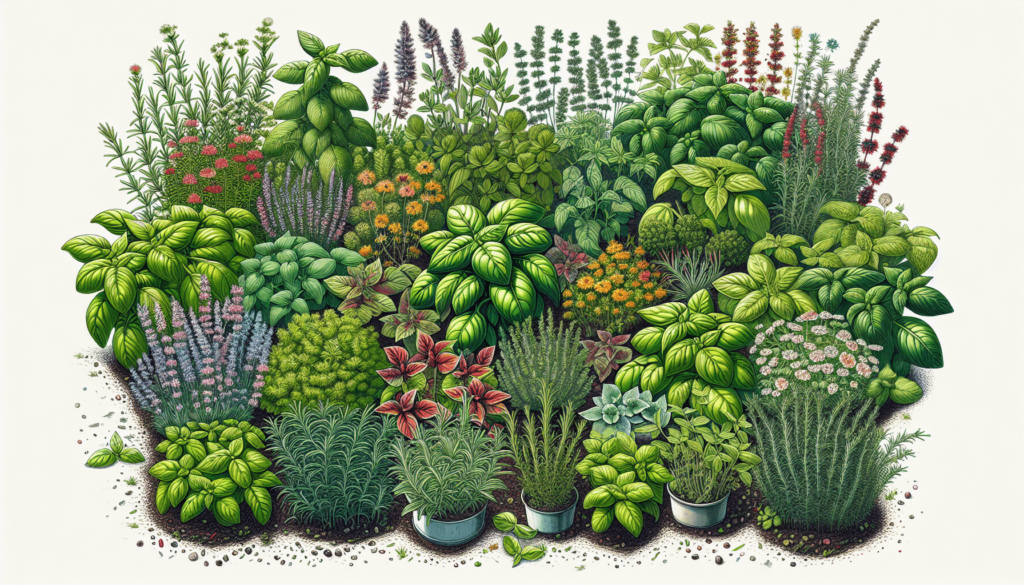So, you’ve got a green thumb and an empty patch of soil just waiting to be filled with an array of vibrant herbs. But here’s the thing – did you know that certain herbs actually grow better when they’re planted together? It’s called companion planting, and it’s all about creating beneficial relationships between different plants. In this article, we’ll explore the world of companion planting specifically for growing herbs. From the classic combination of basil and tomatoes to the surprising partnership of chamomile and cabbage, we’ll uncover the secrets to successfully growing herbs together and maximizing their flavor and growth potential. Get ready to transform your herb garden into a thriving ecosystem of aromatic delights!

Benefits of Companion Planting
Companion planting is an age-old technique that involves planting different crops or herbs in close proximity to one another for mutual benefit. This practice not only promotes healthier plants but also maximizes garden space and creates a diverse and vibrant ecosystem. By understanding the benefits of companion planting, you can unleash the full potential of your herb garden and cultivate a thriving oasis.
Improved Growth and Yields
One of the major advantages of companion planting is its ability to improve the growth and yields of various plants. Certain combinations of herbs can enhance each other’s nutrient uptake, resulting in healthier and more productive plants. For instance, basil and tomatoes make excellent companions as basil releases natural oils that repel pests harmful to tomatoes, while also improving their flavor. By strategically pairing herbs that complement each other’s growth requirements, you can create a harmonious environment that promotes vigorous growth and bountiful harvests.
Natural Pest Control
Dealing with pesky insects can be a daunting task for any gardener, but companion planting offers a natural and effective solution. By interspersing pest-repellent herbs among your crops, you can deter unwanted insects without relying on harmful pesticides. For example, planting chives alongside carrots helps repel carrot flies, allowing your carrots to thrive without interference. By harnessing the power of natural pest control through companion planting, you can protect your herbs and crops while minimizing the use of chemical interventions.
Weed Prevention
Weeding is a time-consuming chore that gardeners often struggle with, but companion planting can help alleviate this burden. Certain herbs have allelopathic properties, meaning they release chemicals that inhibit the growth of weeds. By incorporating these herbaceous allies into your garden, you can suppress the growth of pesky weeds and reduce the need for extensive manual weeding. Mint and lettuce, for instance, make a great pair as mint’s vigorous growth helps shade the soil, preventing weed growth and keeping your lettuce patch weed-free.
Enhanced Flavor and Aroma
Beyond the practical benefits, companion planting can also elevate the culinary experience of your herb garden. Many herbs have complementary flavors and aromas that enhance each other when grown together. For instance, lavender and rosemary complement each other’s earthy and floral notes, providing a delightful sensory experience. By thoughtfully pairing herbs known for their culinary attributes, you can create a harmonious blend of flavors and aromas that will elevate your dishes to new heights.
Herbs That Thrive Together
Now that you understand the numerous advantages of companion planting, let’s explore some specific herb combinations that thrive together. These pairings have been tested and proven to enhance each other’s growth and provide mutual benefits.
Basil and Tomatoes
Basil and tomatoes have a natural affinity for each other and are often found side by side in Italian cuisine. Besides their culinary compatibility, planting basil with tomatoes offers a range of benefits. Basil repels pests such as aphids and whiteflies while also improving the flavor of tomatoes. This synergy makes them an ideal companion duo for both the kitchen and the garden.
Lavender and Rosemary
Lavender and rosemary not only provide a visually stunning combination with their vibrant purple hues and needle-like leaves but also mutually benefit each other. Lavender attracts bees and other beneficial pollinators, which in turn benefit rosemary’s pollination process. Additionally, the aromatic oils released by both herbs act as natural repellents against pests, making them the perfect pairing for a fragrant and pest-resistant garden.
Oregano and Peppers
Planting oregano alongside peppers is a wise choice for both culinary and horticultural reasons. Oregano acts as a natural pest repellent, deterring harmful insects that often target pepper plants. In return, the spicy heat of peppers repels pests that might afflict oregano. This dynamic duo not only minimizes pest damage but also adds depth of flavor to your dishes when harvested together.
Mint and Lettuce
Mint and lettuce, when combined, form a harmonious partnership that benefits both plants. The vigorous growth of mint helps shade the soil, preventing weed growth and providing a cooling effect for the lettuce. Additionally, mint’s aromatic oils act as a natural insect repellent, keeping pests away from your lettuce patch. With this combination, you can enjoy fresh, crisp lettuce while simultaneously keeping your garden lush and pest-free.
Thyme and Cabbage
Thyme and cabbage are a classic pairing that works wonders in the garden. Thyme helps repel cabbage worms and aphids, safeguarding cabbage from common pests. The strong, woody aroma of thyme acts as a natural deterrent against these insects, preserving the health and vitality of your cabbage plants. With thyme as its steadfast companion, your cabbage crop can flourish without the worry of pest infestation.
Complementary Planting Strategies
Companion planting encompasses various strategies that utilize the unique properties of different plants to promote a healthy and thriving garden. By exploring these strategies, you can maximize the benefits of companion planting and create a symbiotic environment for your herbs and crops.
Repellent Plants
Using repellent plants can help ward off pests from your garden. Some herbs, such as marigold, catnip, and chives, possess natural compounds that repel specific pests. For example, planting marigolds near your herbs can deter nematodes and repel squash bugs. By strategically interspersing these repellent plants throughout your garden, you can create a barrier against unwanted pests.
Trap Cropping
Trap cropping involves planting specific crops or herbs to attract pests away from your main crops. By sacrificing a small area of your garden for these trap crops, you can lure pests away from your favorite herbs and vegetables. For instance, planting nasturtiums near cucumbers can divert aphids and cucumber beetles, sparing your cucumbers from infestation. This strategy not only protects your desired plants but also helps maintain a balanced ecosystem.
Aromatic Herbs for Insect Control
Aromatic herbs possess strong scents that can repel insects and pests. By selecting aromatic herbs such as basil, rosemary, and thyme, you can naturally deter pests and safeguard neighboring plants. The oils and aromas released by these herbs act as a natural defense against pests, reducing the need for chemical interventions. Incorporating these aromatic herbs throughout your garden is a proactive way to combat pests and maintain a healthy plant community.
Tall Plants Providing Shade
In a diverse garden, tall plants can provide shade to shorter herbs and crops, helping retain moisture in the soil and prevent weed growth. For instance, planting sunflowers or corn near sprawling herbs like oregano or mint can provide valuable shade while also adding aesthetic appeal. Additionally, the vertical structure of these tall plants can create natural trellises for climbing herbs like peas or beans, optimizing space utilization.
Nitrogen-Fixing Plants for Soil Improvement
Some plants have the remarkable ability to convert atmospheric nitrogen into a form usable by plants, enriching the soil in the process. By incorporating nitrogen-fixing plants like legumes (peas, beans) into your garden, you can improve soil fertility and reduce the need for synthetic fertilizers. These plants work in harmony with neighboring herbs and crops, offering a valuable source of nitrogen while receiving support through companion planting.
Plants to Avoid Planting Together
While companion planting has its benefits, there are also certain combinations of plants that should be avoided due to their antagonistic nature or sharing of specific pests or diseases. By understanding incompatible pairings, you can prevent potential negative interactions and ensure a harmonious garden.
Dill and Carrots
Dill and carrots are incompatible companions, primarily because dill can attract pests that harm carrots, such as carrot flies. The strong scent of dill draws in these destructive insects, making it advisable to keep these two plants separate.
Garlic and Onions
Garlic and onions are members of the same plant family (Allium) and are usually planted together. However, when planted alongside other crops, garlic and onions can inhibit their growth due to their allelopathic properties. It is best to avoid planting garlic and onions near herbs or crops that are sensitive to their influence.
Fennel and Beans
Fennel and beans are known as incompatible companions due to their shared susceptibility to pests and diseases. Fennel can attract aphids and act as a host for rust diseases, which can easily spread to nearby bean plants. It is advisable to keep these two plants separate to minimize the risk of infestations and diseases.
Cilantro and Fennel
While cilantro and fennel are both flavorful herbs, they do not make ideal companions. Planting cilantro near fennel can negatively affect its growth and flavor. Cilantro can bolt or go to seed prematurely when grown near fennel, compromising its culinary quality. To ensure the best results, it’s best to give cilantro its own dedicated space away from fennel.
Companion Planting Chart
To simplify the process of companion planting, referring to a companion planting chart can be immensely helpful. These charts provide valuable information on which herbs and crops are compatible or incompatible, ideal spacing, and layout ideas for creating harmonious combinations.
Layout Ideas for Herb Combinations
Creating a visually appealing herb garden is both satisfying and practical. Using a companion planting chart, you can design your garden layout by grouping compatible herbs together. For instance, you may choose to create a dedicated section for Mediterranean herbs like rosemary, thyme, and oregano, while placing basil and tomatoes nearby for their synergistic benefits.
Ideal Spacing
Proper spacing is essential for companion planting. Each plant requires adequate space to grow and access the necessary sunlight, water, and nutrients. Companion planting charts provide guidance on the ideal spacing requirements for each herb or crop, allowing you to plan your garden accordingly and optimize space without overcrowding.
Compatible and Incompatible Plants
Companion planting charts catalog compatible and incompatible plant pairings, allowing you to make informed decisions and avoid potential conflicts. These charts serve as valuable references, helping you create a harmonious garden by selecting companion plants that complement each other’s growth requirements and discourage potential pests or diseases.
Tips for Successful Companion Planting
To maximize the benefits of companion planting, consider the following tips that will guide you in creating a successful and thriving herb garden.
Consider Plant Height and Sunlight Requirements
When planning your garden, take into account the varying heights of different herbs and their sunlight requirements. Taller plants may cast shade on shorter ones, affecting their growth and productivity. Therefore, it is essential to arrange your herbs accordingly to ensure each plant receives adequate light while avoiding overshadowing.
Rotate Companion Plants Each Season
To prevent the buildup of pests or diseases specific to certain herbs or crops, practice crop rotation each season. By switching the location of your herbs and crops, you break the life cycles of pests and minimize the risk of soil-borne diseases. This rotation also allows the soil to rejuvenate, preventing nutrient depletion and maintaining optimal growing conditions.
Provide Adequate Watering and Drainage
Proper watering and drainage are crucial for the overall health of your plants. Different herbs have varying water requirements, so it is important to group together those with similar needs. Avoid overwatering or underwatering as it can lead to root rot or dehydration. Adequate drainage is equally important to prevent waterlogged soil, which can suffocate plant roots.
Monitor and Remove Diseased Plants Promptly
Even with the best companion planting strategies, some plants may still succumb to pests or diseases. Regularly inspect your herbs and crops for signs of infestation or disease. If any plants are affected, promptly remove them from the garden to prevent the spread to adjacent plants. This proactive approach can save your entire herb garden from devastation and maintain a healthy plant community.
Traditional Companion Planting Wisdom
Companion planting has been practiced and refined throughout history, resulting in various traditional planting techniques that offer timeless wisdom for gardeners. Exploring these traditional methods can provide inspiration and insights into the rich heritage of companion planting.
Native American Three Sisters Planting
The Native American Three Sisters planting is a time-honored method that combines corn, beans, and squash. These three staple crops complement each other in a symbiotic relationship. The corn provides a support structure for the beans to climb while beans fix nitrogen in the soil, benefiting all three plants. The trailing squash leaves create a natural mulch that suppresses weeds and retains moisture. Together, these three crops form a balanced ecosystem and showcase the wisdom of indigenous farming techniques.
French Potager-Style Herb Gardens
Potager-style herb gardens originated in France and are known for their beauty and functionality. These gardens incorporate both culinary and ornamental herbs, arranged in geometric designs to create an aesthetically pleasing and functional space. Herbs with vivid colors and different textures are meticulously paired to create visually striking patterns. This style of companion planting showcases the artistry and creativity that can be achieved while maintaining the practical benefits of companion planting.
Asian Companion Planting Techniques
Asia boasts a rich history of companion planting techniques that prioritize harmony and balance in the garden. The concept of Feng Shui, translated as “wind and water,” applies not only to the arrangement of physical elements but also to gardening practices. In Chinese and Japanese gardens, herbs and crops are carefully selected and placed to promote positive energy flow and maximize the benefits of companion planting. These traditional techniques remind us of the importance of creating balance and harmony in our gardens.
Medieval European Herb Lore
During the medieval period, herb gardens were cultivated for both culinary and medicinal purposes. The layout and selection of herbs were guided by the principles of medieval herb lore, which assigned specific properties and uses to different plants. Herbs were carefully paired based on their supposed synergistic effects, with certain combinations believed to enhance their healing or culinary properties. Though rooted in ancient beliefs, this approach to companion planting reflects the historic significance and reverence associated with herbs.
Herb Pairings for Pest Control
Harnessing the power of herbs for natural pest control is a sustainable and eco-friendly approach to gardening. By incorporating specific companion herbs, you can create a robust defense against common garden pests.
Marigold and Basil
Marigolds and basil form a dynamic duo for pest control. Marigolds emit a strong aroma that repels a wide range of pests, including nematodes, aphids, and whiteflies, making them an excellent plant to include in your garden. Meanwhile, the scent of basil acts as a natural repellent against mosquitoes and flies. Together, these herbs create a multi-level defense against pests while providing vibrant pops of color to your garden.
Chives and Carrots
Chives and carrots make fantastic companions as chives deter pests that commonly afflict carrots, such as carrot flies. The pungent aroma and oils released by chives act as a natural deterrent, keeping pesky insects at bay. Planting chives alongside carrots not only enhances pest resistance but also adds a flavorful and fragrant element to your herb garden.
Nasturtium and Cucumbers
Nasturtiums are a powerhouse companion plant, exhibiting both pest-repellent and trap-cropping benefits. These vibrant flowers repel pests such as aphids, whiteflies, and squash bugs, creating a protective barrier for nearby crops. Additionally, they serve as a trap crop for pests like aphids, attracting them away from more desirable plants such as cucumbers. The attractive flowers and edible leaves of nasturtiums also make for a visually stunning and gastronomically appealing addition to your garden.
Catnip and Squash
Catnip possesses potent insect-repellent properties, acting as a natural deterrent against pests that harm squash plants, such as squash bugs and cucumber beetles. By planting catnip near your squash plants, you create an environment that repels these destructive insects, providing protection for your crop while benefiting your feline companions. Catnip’s fragrant leaves and vibrant flowers also offer visual interest and an aromatic experience for both humans and cats alike.
Herb Companions for Enhanced Growth
Certain herb combinations have been observed to enhance the growth and vitality of plants when planted together. By harnessing these synergistic effects, you can create an environment that promotes optimal growth and harvests.
Chamomile and Kale
Chamomile and kale form a beneficial partnership that promotes the growth and health of both plants. Chamomile enhances kale’s flavor while repelling pests such as aphids and cabbage worms. Kale, in turn, enriches the soil around chamomile with its nutrient-rich leaves as it grows. This partnership demonstrates the mutually beneficial relationship that can arise through companion planting, resulting in stronger and healthier plants.
Sage and Rosemary
Sage and rosemary are both robust perennial herbs that excel when planted together. The aromatic oils released by these herbs act as natural repellents against pests like cabbage moths and carrot flies. Furthermore, their presence in the garden helps deter weeds and enrich the soil through their root systems, contributing to an overall healthier plant community.
Peppermint and Cabbage
Peppermint and cabbage make a delightful pairing that benefits both plants. The strong scent of peppermint repels pests like cabbage butterflies, preventing damage to your cabbage plants. Additionally, peppermint’s vigorous growth shades the soil and suppresses weed growth. In return, cabbage enriches the soil by releasing nutrients that are accessible to the mint’s root system. This partnership creates a robust and healthy garden environment for both plants.
Tarragon and Potatoes
Tarragon and potatoes have a harmonious relationship that promotes the growth and yield of both plants. Tarragon acts as a natural deterrent against pests, protecting potatoes from nematodes and aphids. The strong aroma of tarragon disrupts the sensory receptors of these insects, making them less likely to take up residence. By planting these herbs together, you can enjoy an abundance of flavorful tarragon while safeguarding your potato crop.
Experimenting with Companion Planting
Gardening is an ever-evolving journey of experimentation and discovery. With companion planting, there is a world of possibilities to explore and creative combinations to try. Here are some tips for expanding your companion planting repertoire and continually improving your herb garden.
Keep a Garden Journal
Maintaining a garden journal is a valuable tool that allows you to track your companion planting experiments and document their outcomes. Note the combinations you’ve tried, the successes you’ve observed, and any challenges you’ve encountered. By keeping a record of your gardening experiences, you can learn from past trials and refine your companion planting strategies.
Adjust Based on Your Climate and Soil
Companion planting recommendations are often generalized and can vary based on your specific climate and soil conditions. Adapt your companion planting choices to suit your unique environment. Take into account factors such as temperature, humidity, and soil composition when selecting herb combinations. By tailoring your companion planting to your climate and soil, you can optimize the success of your garden.
Try New Combinations Each Season
Companion planting offers an opportunity for ongoing exploration and experimentation. Embrace the excitement of trying new herb combinations each season to expand your understanding of companion planting and discover novel synergies. This constant curiosity and willingness to try new combinations will breathe fresh life into your herb garden and keep your gardening experience captivating.
In conclusion, companion planting is a practice that brings harmony, diversity, and vitality to your herb garden. By embracing the benefits of improved growth and yields, natural pest control, weed prevention, and enhanced flavors and aromas, you can create a thriving oasis that provides an abundant harvest and a delight to the senses. Experiment with different herb combinations, utilize complementary planting strategies, and draw inspiration from traditional wisdom. With each season, your knowledge and mastery of companion planting will grow, and your herb garden will flourish with vibrant life.





